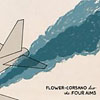 Mick Flower and Chris Corsano are no newcomers to the world of freely improvised music, and their numerous accolades more than summarize their collective achievements. Yet the two musicians play in such a broad spectrum of situations that sometimes it is difficult to tell just what the core of their sound is. On their second full length as a duo however, they are stripped of any external distractions in favor of head-to-head improvisational conversations, a setting that both thrive in.
Mick Flower and Chris Corsano are no newcomers to the world of freely improvised music, and their numerous accolades more than summarize their collective achievements. Yet the two musicians play in such a broad spectrum of situations that sometimes it is difficult to tell just what the core of their sound is. On their second full length as a duo however, they are stripped of any external distractions in favor of head-to-head improvisational conversations, a setting that both thrive in.
The album opens with a bang as Corsano's drums and Flower's virtuosic Japan Banjo (or Shaahi Baaja) explode forth for "I, Brute Force?," a propulsive shredding session that finds fertile exploratory ground in the brief gaps allotted by Lightning Bolt levels of energy. Corsano's drumming can rival anyone's, and his playing here is absolutely frenetic, bounding across, over and through Flower's arbeggiated shards with reckless confidence. There are few sounds so unique in improvised music today, and the duo's perfection of this kind of head-on freedom is rarely matched in any circle. Beneath all of the notes—and there are plenty—is an overall shape the form of which unravels with patience and (relative) clarity, but whose moment to moment discourse of ideas is that of a structure far briefer in length.
If the first track represents the duo's forte, the rest of the album displays its depth. Both members' instrumentation extends beyond their usual associations, as Corsano variously picks up a melodica and cello while Flower also plays tanpura and organ. This provides some necessary pockets for the two to extend into and they take full advantage of it. On "The Three Degrees of Temptation," Corsano's pot and pan drum kit rattles, shakes and chimes beneath Flower's nimble string manipulations, creating an eerie and amorphous spatial realm.
This sparse sound is counteracted by the thick duel-string drones on the following track, "The Drifter's Miracles." True to Flower's Vibracathedral Orchestra roots, the number finds the ample dialogue to be had between La Monte Young's drone experiments, contemporary free drone music and Japanese shamisen. Corsano's cello undulates underneath while Flower ornaments his moves with layer after layer of shapes that change effortlessly despite the consistent density of sound.
The duo return to what appears to be their signature sound on "The Beginning of the End," although this time the proceedings maintain a distinctly Skaters-like feel as Corsano's drums patter about beneath Flower's riffage. While the approach may be the same, it's encouraging—though not surprising—that the unit can extend it into different modes through what they're playing rather than how loud or fast they are.
The closing track, "The Main Ingredient," is the longest here, and the duo takes advantage of the length to explore depths previously only hinted at. Building into a frenetic and undulating weight, the unit moves with a singular vision all too rare. Instant response is one thing, but Flower and Corsano can shift mood along with tempo, atmosphere with melody and approach with feel. This sort of elasticity and balance results in some of the most distinctly surprising and exciting sounds happening today. And the long raga-like fade out at the end? It only encourages another go.
samples:
Read More

